Edwin Beard Budding, an engineer born in Eastington, Stroud, was the English inventor of the lawnmower (1830) and adjustable spanner (1842).

A scythe is an agricultural hand tool for mowing grass or harvesting crops. It is historically used to cut down or reap edible grains, before the process of threshing. The scythe has been largely replaced by horse-drawn and then tractor machinery, but is still used in some areas of Europe and Asia. Reapers are bladed machines that automate the cutting of the scythe, and sometimes subsequent steps in preparing the grain or the straw or hay.
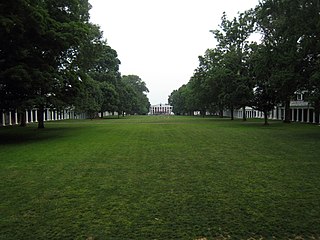
A lawn is an area of soil-covered land planted with grasses and other durable plants such as clover which are maintained at a short height with a lawn mower and used for aesthetic and recreational purposes—it is also commonly referred to as part of a garden. Lawns are usually composed only of grass species, subject to weed and pest control, maintained in a green color, and are regularly mowed to ensure an acceptable length. Lawns are used around houses, apartments, commercial buildings and offices. Many city parks also have large lawn areas. In recreational contexts, the specialised names turf, pitch, field or green may be used, depending on the sport and the continent.

A lawn mower is a device utilizing one or more revolving blades to cut a grass surface to an even height. The height of the cut grass may be fixed by the design of the mower but generally is adjustable by the operator, typically by a single master lever or by a mechanism on each of the machine's wheels. The blades may be powered by manual force, with wheels mechanically connected to the cutting blades so that the blades spin when the mower is pushed forward, or the machine may have a battery-powered or plug-in electric motor. The most common self-contained power source for lawn mowers is a small internal combustion engine. Smaller mowers often lack any form of self-propulsion, requiring human power to move over a surface; "walk-behind" mowers are self-propelled, requiring a human only to walk behind and guide them. Larger lawn mowers are usually either self-propelled "walk-behind" types or, more often, are "ride-on" mowers that the operator can sit on and control. A robotic lawn mower is designed to operate either entirely on its own or less commonly by an operator on a remote control.

A mulch is a layer of material applied to the surface of soil. Reasons for applying mulch include conservation of soil moisture, improving fertility and health of the soil, reducing weed growth, and enhancing the visual appeal of the area.

A mower is a person or machine that cuts (mows) grass or other plants that grow on the ground. Usually mowing is distinguished from reaping, which uses similar implements, but is the traditional term for harvesting grain crops, e.g. with reapers and combines.

Robomow is a manufacturer of robotic lawn mowers. Founded in Even Yehuda, Israel in 1995 by Udi Peless and Shai Abramson, the company provides robotic lawnmowers to the United States and Europe, with prices ranging from hundreds to thousands of dollars/Euros. Robomow mowers are rechargeable, environmentally-friendly designed to meet all safety standards. Robomow also comes with its own mobile application for remote and interactive control. The company has been mentioned in several magazines including: Design News, Business Wire, Washington Home and Garden and Vanity Fair. In May 2017, MTD Products Inc announced their intent to purchase Friendly Robotics. In July 2017, MTD Products announced the completion of the purchase of Robomow.
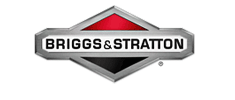
Briggs & Stratton Corporation is an American manufacturer of gasoline engines with headquarters in Wauwatosa, Wisconsin.

Lawnmower racing is a form of motorsport in which competitors race modified lawnmowers, usually of the ride-on or self-propelled variety. The original mower engines are retained, but blades are removed for safety. The sport attracts all ages, and is usually entered into in a spirit of fun rather than extreme competitiveness, though many participants do take it seriously.
Gravely, of Brillion, Wisconsin, is a manufacturer of powered lawn and garden implements which it describes as "walk-behind, zero turn and outfront mowers". It started as a manufacturer of "walk-behind" or two-wheel tractors.
An edge trimmer or lawn edger is a garden tool, either manual or motorised, to form distinct boundaries between a lawn, typically consisting of a grass, or other soft botanical ground cover, and another ground surface feature such as a paved, concreted or asphalted area, or a granular material such as sand or gravel, or simply uncovered soil, for example an unbounded garden.

The Claas Cougar is a self-propelled mower produced by the German agricultural machinery manufacturer Claas. The mower, which is named after the cougar, a large American cat, was first presented in 2003. Due to its maximum cutting width of 14 metres (46 ft) it is classified as the largest self-propelled mower in the world.

A conditioner is a farm implement that crimps and crushes newly cut hay to promote faster and more even drying. Drying the hay efficiently is most important for first cutting of the hay crop, which consists of coarse stalks that take a longer period of time to draw out moisture than finer-textured hays, such as second and subsequent cuttings.
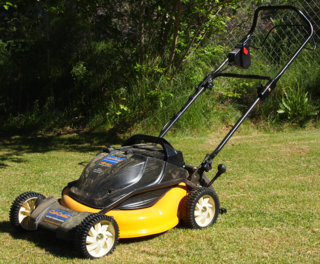
Grasscycling is a method of handling grass clippings by leaving them to decompose on the lawn when mowing. The term combines "grass" and "recycling", and had come into use by at least 1990, as part of the push to reduce the huge quantities of clippings going into landfills, up to half of some cities' summertime waste flow, as 1,000 square feet of lawn can produce 200 to 500 pounds of clippings a year.

A flail mower is a type of powered garden/agricultural equipment which is used to deal with heavier grass/scrub which a normal lawn mower could not cope with. Some smaller models are self-powered, but many are PTO driven implements, which can attach to the three-point hitches found on the rear of most tractors. This type of mower is best used to provide a rough cut to long grass and even brambles in locations such as roadsides, where contact with loose debris may be possible.
A roller mower, or rollermower, is a tractor-powered multi-spindled rotary mowers that have full width rollers front and rear. Most rollermowers attach to a four-wheeled tractor via the three-point linkage and are powered by the tractor's power take-off (PTO), though larger models connect three or more complete mowing decks to a separate chassis that is towed behind the tractor. Good rollermowers can produce a finish rivalling that of reel (cylinder) mowers while generally being far more robust and requiring considerably less maintenance. Modern machines can also cope efficiently with a wider range of grass lengths and densities than cylinder mowers.
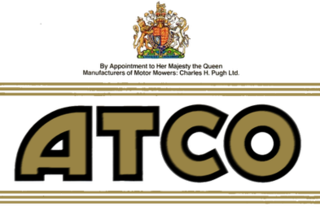
Atco (Atlas Chain Company) Limited was a British mower company which traded as "Atco Ltd" from 1981 to 1990, making lawn mowers and garden tools. It sold a range of lawn mowers including lawn and garden tractors.
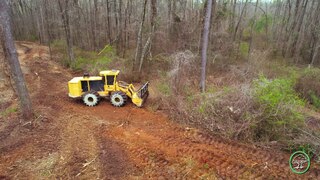
Forestry mulching is a land clearing method that uses a single machine to cut, grind, and clear vegetation.

The Worthington Mower Company, originally called the Shawnee Mower Factory, produced lawn mowers and light-duty tractors in the United States from the early 1920s until around 1959. Founded by Charles Campbell Worthington and run as a family business, in 1945 it was purchased by Jacobsen Manufacturing. It continued to produce tractors and mowers in Stroudsburg, Pennsylvania, until around 1959.

Hayter is a British high-end manufacturer and distributor of garden machinery, specialising in industrial and domestic lawn mowers. The company's headquarters are located in Spellbrook, Hertfordshire, where it was founded in 1946 by Douglas Hayter, a pioneer of the rotary mower. The company was awarded a Royal Warrant in 1960.















